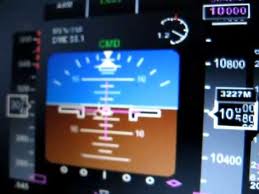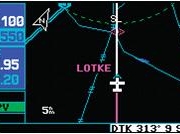Situation:
You are on the final approach course to a major international airport in a light turbine aircraft. ATC is keeping you high and fast to blend you with the arriving heavy jet traffic on this busy hour of the day.
At the last minute, you are issued a visual approach clearance. However, you are way above your vertical profile and recommended approach speed for a stabilized approach due to ATC restrictions.
You still have a few miles to go, so you elect to slow down the aircraft and lower the gear. Your company SOP (Standard Ops Procedures) dictates that to maintain a stabilized approach criteria, you must not exceed a 1,500’/min rate of descent. You then decide to use full flaps in order to allow for a descent without exceeding that criteria in order to land within the recommended portion of the runway.
Everything goes well, and while you are descending at 1,500’/min the whole way down, you never depart from a stabilized profile during the approach. You must land within the first third of the runway or execute an overshoot as per SOPs. Luckily all goes well and you had planned perfectly, landing with a few feet to spare.
Question:
The use of full flaps slowed you down almost to a crawl during the approach. Although you made the runway without the need of any deviation from a standard approach profile, you know that ATC was counting on you to maintain a fast pace to accommodate following traffic.
Would you have been able to land within the first third of the runway while using less flaps and a higher approach speed?
Leave your comments and thoughts in the comment box below! 🙂





wow. nobody since 2011?
i’ll bite: my first thought is “sure, just slide it down”, but i have a hunch that’s not exactly SOP for any airline (i mean approaching with a higher speed, less flaps, but “sideways”, i see the accepted term is “slip” as explained here http://en.wikipedia.org/wiki/Slip_%28aerodynamic%29). I’m not sure that’s better than pulling the flaps and having ATC deal with it though
the main danger with a slip is that, being aerodynamically “wrong”, it can very easily be overdone and one could potentially stall, which is not exactly what you want on approach.
having said that, slips should be part of any pilots training, so that shouldn’t be a problem 😛
i’m trying to think of other ways, but this sounds like the natural choice; i suppose if the turboprop in question can do “beta pitch” (i think it’s called?) that could also be used effectively, but i’m not very familiar with turboprops, so i’m not sure you are actually supposed to use the beta range in that way (relatively long term, at considerable speeds), from what i read here and there it seems with some it might be.
sidenote: just discovered your site, i think i’m going to read some more 😉
Well thought and written 🙂
Here is the trick – it is highly unadvised to use beta on a turbine in flight. Sure it will slow you down but.. It’s never been part of an aircraft’s limitations to allow this as far as I know.
Side Slip is another technique which- like you mentioned – every pilot should be proficient at. However, It would make your passengers quite distressed due to the unusual attitude and forces exerted on the airplane. I wouldn’t suggest it.
The real answer however lies in the three factors in play: Distance available, Rate of Descent limitation and forward airspeed.
In order to lose, say 10,000′ in a finite distance, you have to achieve a certain rate of descent in respect to your forward airspeed. The faster you are moving forward, the faster you have to lose altitude. So in order to reduce or maintain a given rate of descent, the only thing you can control is forward speed.
Slower forward speed with a fixed rate of descent means you’re now losing more altitude per traveled miles.
Thoughts? 😉
yeah, that’s basically what i realized “overnight”, not sure if you saw my second comment (still waiting for moderation): obviously, with said limitations, one is out of luck, as long as the rate of descent is caped and minimum speed set.
another way to look at it is you have x energy (invested in height and forward speed), and you need to arrive at the “threshold” (is that the correct term? where the final approach phase is basically finished, and you’re easing on the stick backwards to start the flare — if you can afford a flare), so you need to arrive there with a certain energy y (lower: lower height, and usually lower speed too), so you need to get rid of this energy on the way somehow (main two ways would be friction and reverse propulsion, head wind being arguably in the reverse propulsion camp). now, if you limit the rate at which you can get rid of potential energy (height), and you put a lower limit on the forward ground speed, and the starting point is fixed, as most pilots can’t invoke headwinds at will, there’s really nothing left to play with: it either works or it does not: even disregarding the kinetic energy you arrive with (just to simplify, let’s say you can use the engine to slow down quickly at the last moment as needed, to prepare the actual touchdown), you’re looking at shedding all that potential energy in a given amount of time (given because we’ve limited how slow we can go), which at the end of the day translates into feet per minute, which means you either have room to do it at a certain descent rate and speed, or you don’t. Unless you cheat and slow down heavily on the last part of the approach (making your average approach speed the same as the one we’re trying to avoid), and i also have a hunch that’s not exactly sop, and a bigger headache to atc by far (unpredictable — it’s probably borderline unacceptable, i don’t know, i never had the pleasure to deal with atc 🙂 )
even more interestingly, if you do have a headwind, it works for you in the same way it works for the big fast jets, so we’re back to square one: if you need to keep up with them, nothing has changed, the mass of air you’re flying in happens to be moving (or, if you like, the target happens to be moving away from you), but it’s doing so at the same rate for everybody, so even with a good connection upstairs and invoking that headwind, nothing changes.
it appears the only reasonable solution is for atc to take into account they are bringing in a turboprop not a jet, and plan the incoming approaches accordingly. One possible theoretical “comfortable” solution might be to lengthen the final of the turboprop compared to the jets (so let the turboprop start it’s descent farther away, on a shallower slope, so it can stay reasonably fast and still have time to lose the energy it needs to lose); but this sounds like more trouble: you end up with jets coming in on an approach profile and the turbine on a different, shallower one, not to mention some (most?) airports can’t tolerate such creative approaches due to obstacles on final. Even if you could, you have the turbine now on what is essentially it’s own approach, so it almost doesn’t matter anymore who goes how fast.
so, what am i missing? 🙂
I’d be hard pressed to find anything you’ve missed! On a side note – Jets have a LOT of inertia to lose but they have spoilers at their disposal to destroy the lift/speed. ATC will also always give them much more space to maneuver. The situation we found ourselves in with the turboprop was due to a last minute runway change (ATC offered us a straight in approach rather than a circuit for the other end) so it made things interesting. But fun nonetheless!
yeah, i know, it’s horribly long. you got me thinking, and i forgot myself, should have made it shorter. given that the whole gist of that novel is “the answer is no.”… could probably stand to be deleted ;
spoilers/airbrake: well, they are nice especially when you have a good gliding airframe (extreme example being a glider, they all (or most) have airbrakes/spoilers for a reason), but this comes down to high descent rate at the end of the day (which is the limiting procedural factor here).;
I think, theoretically, there’s nothing an airbrake can do which you cannot do with a generous amount of slip (can’t help myself 🙂 ), i *think* you will probably hit the practical aerodynamic limits about the same place with both methods (both the air brake and the slip will make you stall at some point, and i think overall it will be about the same point, because energy wise it’s the same thing — in fact, all else being equal, i’d expect the slip to take you a bit further in safety (descent rate wise) than the airbrake can, but that’s already gut feeling, and i might be totally wrong; only a proper airframe designer/engineer can really say); the feeling inside the cabin induced by a _serious_ slip.. people pay for roller-coaster rides, right? 🙂 (joke aside, i’m not sure if you ever flew gliders, but i think you’d love it if you haven’t) ;
i digress again, sorry. what i wanted to say: thank you specifically for the insight into proper controlled airport procedures, i’m not familiar with them, so i couldn’t completely understand your reference “At the last minute, you are issued a visual approach clearance.” (which otherwise says everything), until your explanation in the last post. is that to say the approach path (slope, starting point etc) will in fact indeed be completely different for the turbines, and in this case it just happened the proposed approach was already “borderline” (tight)?;
thanks again, very interesting site. Can we have a series of “aeronautical brain teasers”? even if nobody else steps up, i promise to annoy you regularly with attempted answers 🙂 ;
ps: uggh, another short one :/
Hi!
I’ve never flown gliders but it sounds like an amazing adventure! Yeah I know sideslips answer a lot of questions that way but sadly in the commercial world let’s say they are frowned upon.. and most of the time not approved in Standard Operating Procedures.
I’m glad you enjoyed this! I will try to post a few more as I go. Thank you for the interaction and the comments! 🙂